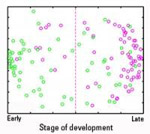Genetic parallels found between lung development and lung cancer

Genes whose activity is increased in adenocarcinoma (green circles) tend to be active early in lung development, while genes with reduced activity (magenta) tend to be active late in development.
For over 100 years, biologists have speculated that cancer growth shares common features with embryonic development. Researchers at Children's Hospital Boston now provide solid evidence for this idea, showing through gene-chip analyses and bioinformatics techniques that many genes that are differentially expressed (turned “up” or “down”) during early embryonic lung development are also differentially expressed in lung cancer.
More importantly, they show that gene-expression profiling can predict a lung cancer's prognosis, and that cancers whose gene expression pattern resembles gene expression during the earliest stages of lung development have the worst prognosis of all.
“This confirms our earlier finding of the importance of normal organ development in understanding cancer,” says Isaac Kohane, MD, PhD, director of the CHIP program and a co-author on the paper. “Our observations might translate into more accurate prognoses and help us identify mechanisms of cancer growth that can be therapeutically targeted.”
Lung cancer, the world's leading cause of cancer deaths, has many known subtypes, but it is commonly misclassified, delaying appropriate treatment. In addition, cancers within a subtype may vary in their aggressiveness.
Seeking a better way to classify lung cancers, Hongye Liu, PhD, and colleagues in the Children's Hospital Informatics Program (CHIP) examined gene activity in tumors from 186 patients and compared it with the gene activity that occurs during normal embryonic lung development in mice. They also examined 17 samples of normal lung tissue. Starting with 3,500 genes known to be common to mice and humans, they identified 596 genes whose activity was altered both in lung tumors and during lung development.
Using the natural trajectory of lung development as a framework, Liu and colleagues were able to predict survival in patients with adenocarcinoma (the most common type of lung cancer, and the only type for which they had survival data). Tumors with gene expression patterns most like those during very early lung development had the worst prognosis, while tumors with gene expression patterns resembling those seen late in lung development had the best prognosis. Even within a single adenocarcinoma subtype – stage I disease – survival times varied according to gene expression patterns. Gene expression patterns in normal lung tissue resembled those seen in late in lung development.
“Before, the idea that cancer and organ development are related was not quantified or statistically significantly demonstrated,” says Liu. “The development perspective gives us a new mechanism for understanding cancer.”
The researchers also found that one lung cancer subtype, carcinoid tumors, have a gene expression profile distinct from all the others. When biopsy specimens are examined, carcinoid looks very similar to small-cell lung cancer, and the two are often mistaken for each other, yet their life expectancy and optimal treatments are very different. “By molecular profiling, we can distinguish these two cancers,” Liu says.
In addition, focusing on the 100 genes with the greatest cancer/development correlation, Liu and colleagues found three groups of genes that are involved in biological pathways believed to be key in lung cancer development, and some of the genes showed potential as drug targets. Several genes had stem-cell-like characteristics.
Liu's work builds on a 2004 study, in which Kohane and Alvin Kho, PhD (another co-investigator on Liu's study) showed that a pediatric brain tumor called medulloblastoma shares many common genetic features with the cerebellum in its earliest stages of development (www.childrenshospital.org/newsroom/Site1339/mainpageS1339P1sublevel81.html).
Media Contact
More Information:
http://www.harvard.eduAll latest news from the category: Life Sciences and Chemistry
Articles and reports from the Life Sciences and chemistry area deal with applied and basic research into modern biology, chemistry and human medicine.
Valuable information can be found on a range of life sciences fields including bacteriology, biochemistry, bionics, bioinformatics, biophysics, biotechnology, genetics, geobotany, human biology, marine biology, microbiology, molecular biology, cellular biology, zoology, bioinorganic chemistry, microchemistry and environmental chemistry.
Newest articles

Properties of new materials for microchips
… can now be measured well. Reseachers of Delft University of Technology demonstrated measuring performance properties of ultrathin silicon membranes. Making ever smaller and more powerful chips requires new ultrathin…

Floating solar’s potential
… to support sustainable development by addressing climate, water, and energy goals holistically. A new study published this week in Nature Energy raises the potential for floating solar photovoltaics (FPV)…

Skyrmions move at record speeds
… a step towards the computing of the future. An international research team led by scientists from the CNRS1 has discovered that the magnetic nanobubbles2 known as skyrmions can be…





















